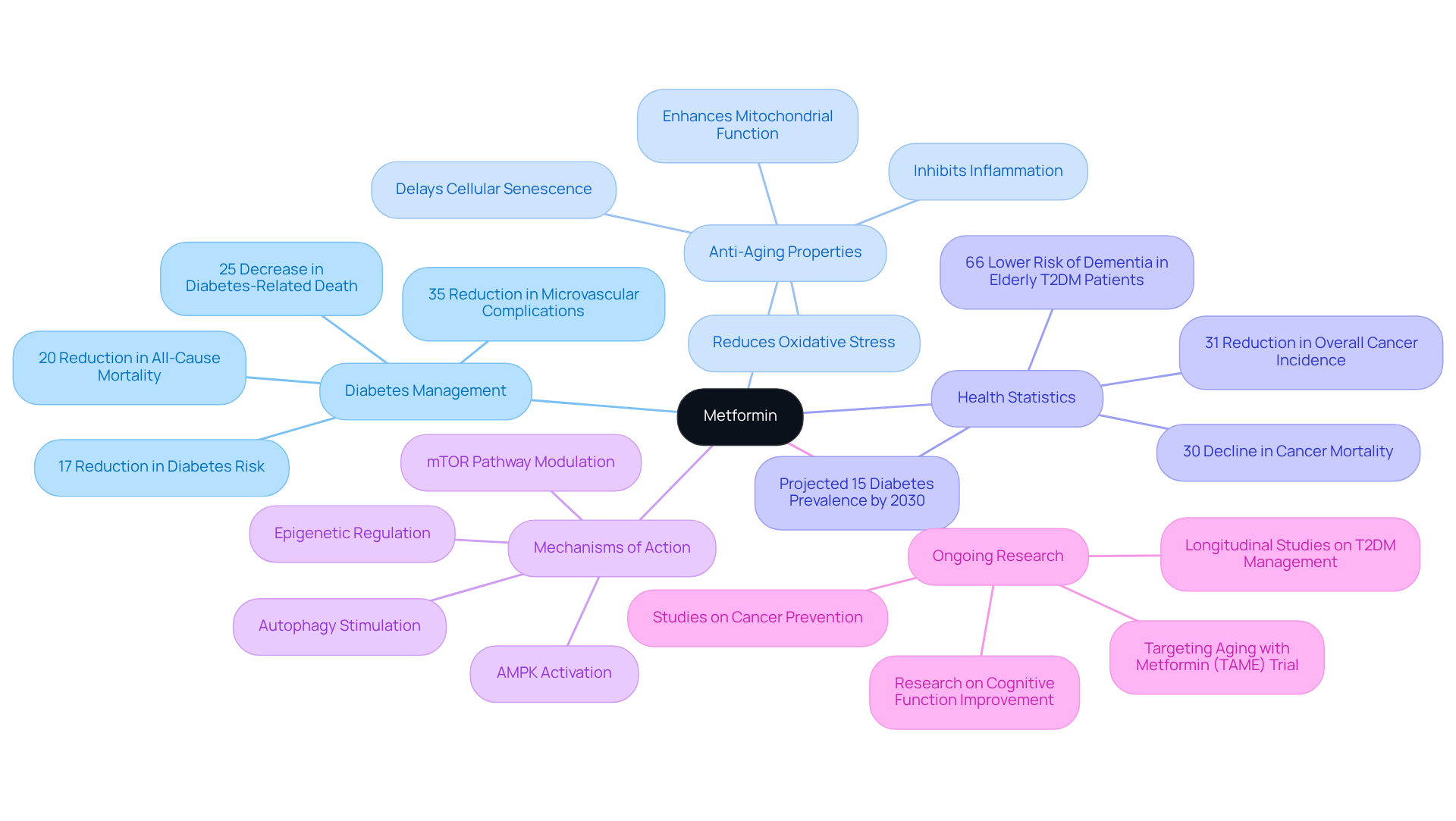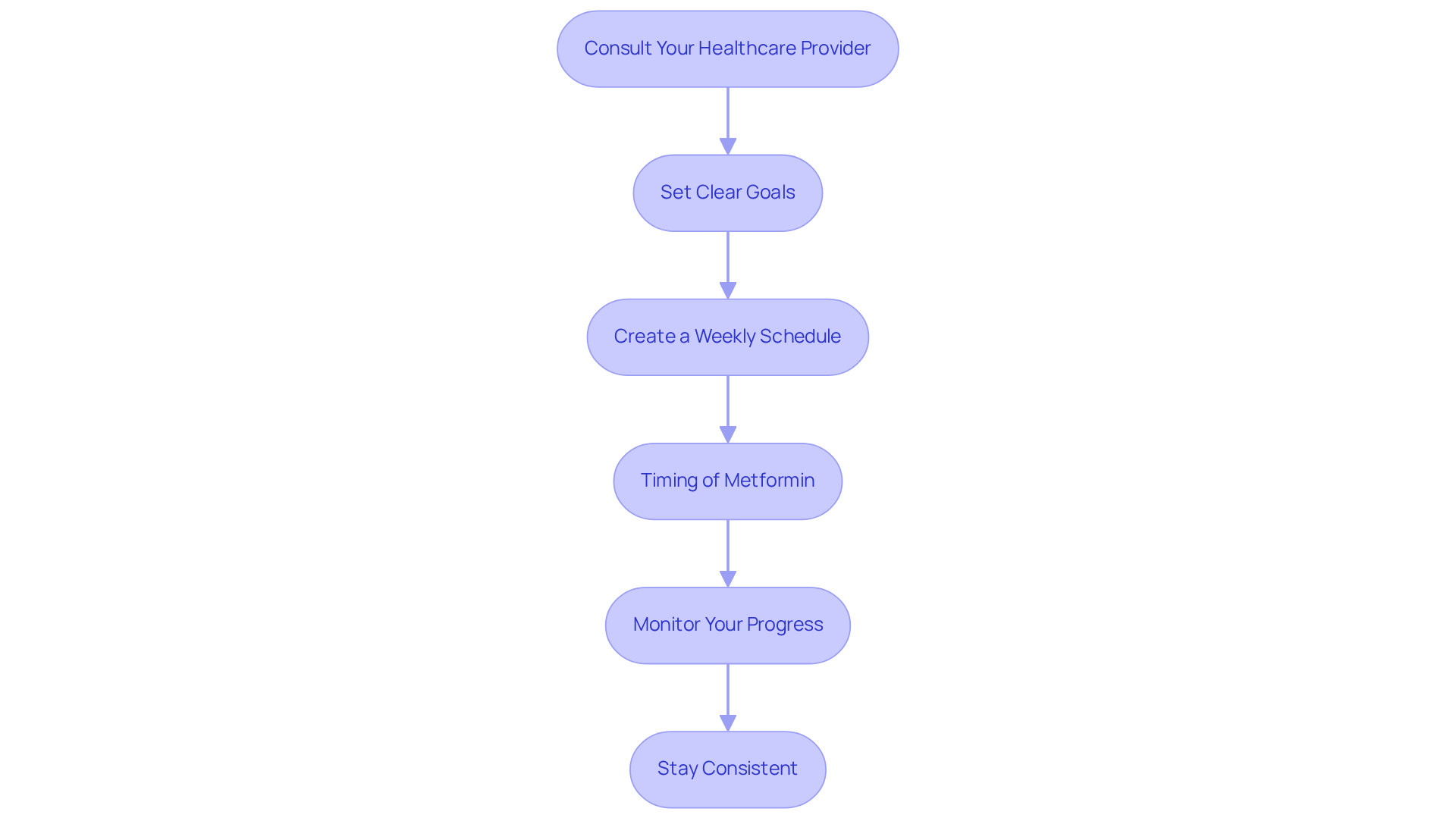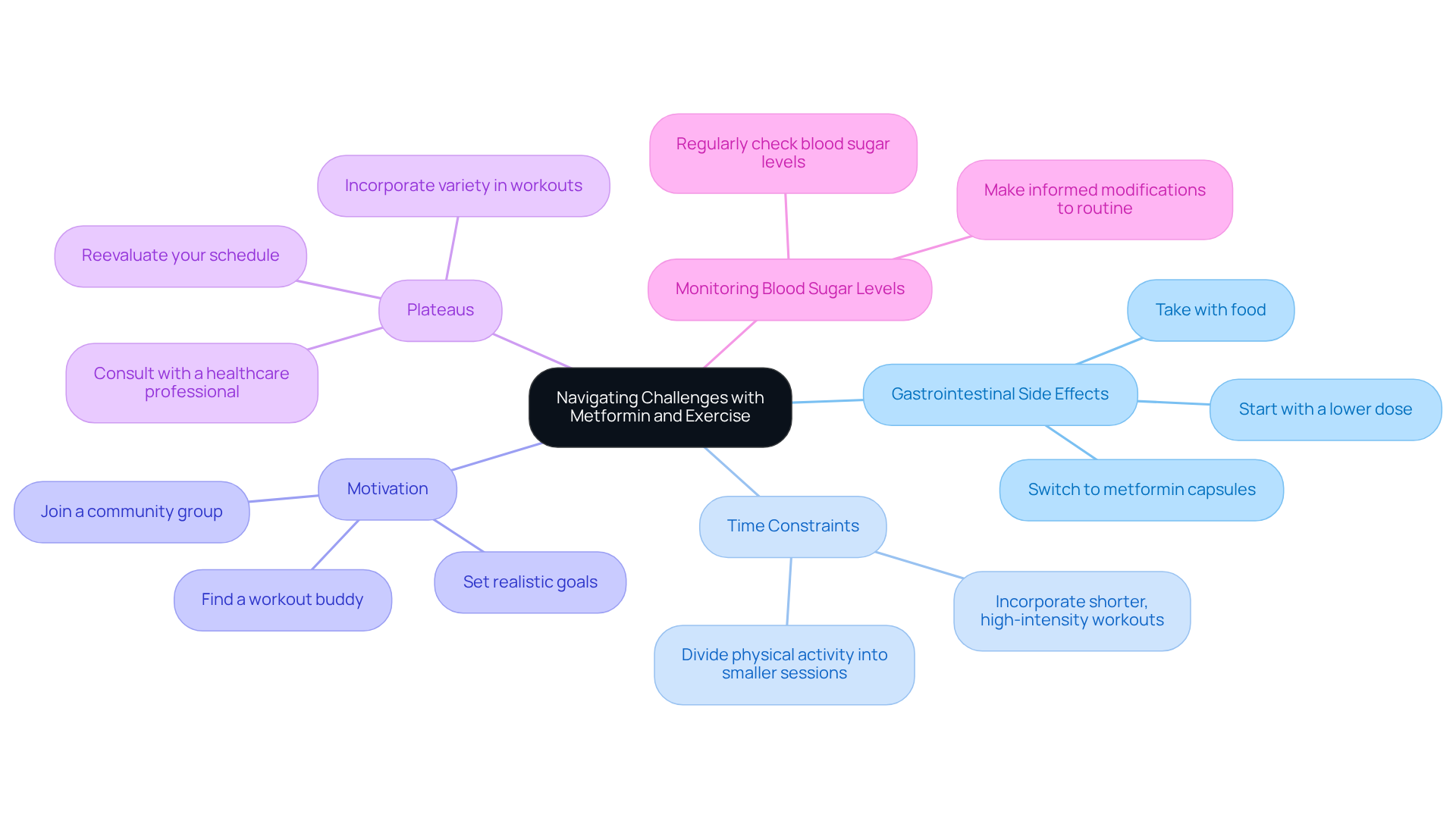Master Metformin and Exercise for Optimal Health Benefits
Overview
This article explores the effective combination of metformin and exercise to achieve optimal health benefits, particularly in managing type 2 diabetes and promoting longevity. It highlights the synergistic effects of metformin and physical activity on insulin sensitivity and glycemic control. Furthermore, it provides practical steps for creating a structured regimen that addresses common challenges faced by individuals seeking to enhance their health outcomes.
Introduction
Metformin has long been recognized as a key player in managing type 2 diabetes. However, its benefits extend far beyond mere glucose control. Recent research suggests that this medication may hold the key to healthier aging, reducing the risk of chronic diseases, and even enhancing longevity. As individuals increasingly seek ways to optimize their health, understanding how to effectively combine metformin with regular exercise emerges as a vital strategy.
What are the best practices for navigating the challenges of this combination?
How can one ensure they are maximizing the health benefits of both?
Understand Metformin and Its Role in Health
Metformin is a cornerstone in the management of type 2 diabetes, operating by reducing hepatic glucose production, enhancing insulin sensitivity, and promoting peripheral glucose uptake. Recent studies have illuminated its potential anti-aging properties, suggesting that this compound may decelerate the aging process and mitigate the risk of age-related diseases. For instance, studies show that this medication can decrease the likelihood of developing diabetes by 17% and is linked to a 30% decline in the risk of dying before age 90 compared to other therapies. Furthermore, this medication has been associated with a 35% reduction in cancer mortality and a 31% decline in overall cancer incidence, further highlighting its advantages for well-being.
In addition, the medication’s capacity to enhance mitochondrial function and diminish oxidative stress establishes it as a promising approach for longevity. As people progressively pursue methods for healthy aging, comprehending its diverse function in metabolic well-being becomes essential, especially for those looking to improve their vitality and longevity. The ongoing Targeting Aging with Metformin (TAME) trial aims to provide key evidence on its efficacy in delaying aging in humans, underscoring the importance of continued research in this area. As observed by researcher Ting Zhang, “Recent studies have revealed various molecular mechanisms through which this medication extends its advantages beyond glycemic control, positioning it as a promising approach against aging.

Explore the Synergy Between Metformin and Exercise
The combination of metformin and exercise has demonstrated significant cooperative effects on metabolic well-being. Consistent physical exercise enhances the body’s insulin utilization, while the medication itself improves insulin sensitivity. Research shows that individuals who use metformin and exercise regularly in their routines experience more pronounced improvements in glycemic control compared to those who depend solely on medication.
For instance, one study revealed that exercising after meals can lead to an impressive 21% reduction in peak glucose levels among users of the medication. This synergy not only facilitates effective blood sugar management but also aids in weight control and promotes cardiovascular health, establishing a robust strategy for those aiming to optimize their overall well-being.
Furthermore, evidence suggests that the combination of metformin and exercise can amplify the insulin-sensitizing effects of this medication, making it an essential component of diabetes management. Real-life examples highlight how individuals have successfully improved their glycemic control through a combination of medication and regular physical activity, underscoring the importance of an active lifestyle in managing type 2 diabetes.

Implement a Structured Routine for Metformin and Exercise
To efficiently blend medication and physical activity, creating a well-organized regimen is essential. Here are actionable steps to create your regimen:
- Consult Your Healthcare Provider: Before beginning metformin and exercise or a new workout regimen, consult with your healthcare provider to ensure it aligns with your wellness objectives and to discuss any possible interactions.
- Set Clear Goals: Define your objectives, whether it’s weight loss, improved blood sugar control, or enhanced overall fitness. Setting specific, measurable, attainable, realistic, and time-bound (SMART) goals increases the likelihood of success.
- Create a Weekly Schedule: Aim for at least 150 minutes of moderate-intensity aerobic activity each week, such as brisk walking or cycling. Include strength training workouts at least two times a week to improve muscle mass and metabolic function. As noted by health organizations, “Any physical activity is better than none at all, but most health organizations say you need a minimum of 150 minutes of activity per week to reap significant results.”
- Timing of Metformin: Take metformin as prescribed, typically with meals to minimize gastrointestinal side effects. Consider timing your workout sessions to optimize glucose control, such as engaging in physical activity after meals, which can help regulate blood sugar levels more effectively with metformin and exercise.
- Monitor Your Progress: Regularly track your blood sugar levels, weight, and physical activity performance to assess the effectiveness of your routine. Adjust your regimen based on these metrics to ensure continued progress. Research indicates that supervised exercise programs significantly improve glycemic control in adults with type 2 diabetes, highlighting the importance of monitoring.
- Stay Consistent: Consistency is essential for reaching your wellness objectives. Strive to stick to your routine, yet stay adaptable and modify as needed according to your body’s reactions and any alterations in your well-being.
By adhering to these steps, individuals can develop a balanced strategy that enhances the advantages of both medication and physical activity, resulting in better wellness outcomes.

Navigate Challenges and Optimize Your Approach
While combining metformin and exercise can provide considerable health advantages, obstacles may occur. Here are some common obstacles and strategies to overcome them:
-
Gastrointestinal Side Effects: Metformin can cause digestive issues, including bloating and diarrhea. To mitigate this, start with a lower dose and gradually increase it as tolerated. Taking it with food can also help. Furthermore, studies indicate that switching to metformin capsules may lead to fewer side effects, with 78.67% of patients reporting reduced gastrointestinal discomfort after making the switch.
-
Time Constraints: Busy schedules can make it challenging to find time for physical activity. Consider incorporating shorter, high-intensity workouts or dividing physical activity into smaller sessions throughout the day. In addition, studies indicate that shorter, more intense workouts can improve commitment and facilitate incorporating physical activity into your daily schedule.
-
Motivation: Staying motivated can be challenging. Set realistic goals, find a workout buddy, or join a community group to enhance accountability and enjoyment. Health experts recommend that social support can greatly enhance compliance with fitness routines.
-
Plateaus: If progress stalls, reevaluate your schedule. Incorporate variety in your workouts, adjust your diet, or consult with a healthcare professional for personalized advice. Specialists advise frequently altering your workout regimen to avoid plateaus and sustain interest.
-
Monitoring Blood Sugar Levels: Regularly check your blood sugar levels to understand how your body reacts to the medication and exercise. This information can assist you in making informed modifications to your routine, ensuring optimal well-being outcomes. A systematic review found that patients treated with this medication have a higher risk of gastrointestinal adverse events, making monitoring even more crucial.
By proactively addressing these challenges, you can optimize your approach to health and maximize the benefits of combining metformin and exercise.

Conclusion
The integration of metformin and exercise presents a powerful strategy for enhancing health and longevity. By understanding the multifaceted benefits of metformin—particularly its role in managing type 2 diabetes and its potential anti-aging properties—individuals can harness its full potential. When combined with regular physical activity, the effects on glycemic control, weight management, and overall well-being become even more pronounced, creating a holistic approach to health.
Key insights illustrate the importance of a structured routine that includes both medication and exercise:
- Consulting healthcare providers
- Setting clear goals
- Monitoring progress
Each step plays a crucial role in optimizing health outcomes. Overcoming challenges such as gastrointestinal side effects, time constraints, and motivation can further enhance the effectiveness of this combined approach, ensuring that individuals can maintain their commitment to a healthier lifestyle.
Ultimately, the synergy between metformin and exercise not only supports better management of diabetes but also promotes a proactive stance on aging and overall health. Embracing this dual strategy can lead to significant improvements in quality of life, making it essential for those seeking to enhance their well-being. Taking action today by implementing these practices can pave the way for a healthier tomorrow, underlining the transformative potential of this powerful combination.
Frequently Asked Questions
What is Metformin and its primary use?
Metformin is a medication primarily used in the management of type 2 diabetes. It works by reducing hepatic glucose production, enhancing insulin sensitivity, and promoting peripheral glucose uptake.
What potential benefits of Metformin have recent studies suggested?
Recent studies suggest that Metformin may have anti-aging properties, potentially decelerating the aging process and reducing the risk of age-related diseases.
How does Metformin impact the risk of developing diabetes and overall mortality?
Metformin can decrease the likelihood of developing diabetes by 17% and is associated with a 30% decline in the risk of dying before age 90 compared to other therapies.
What effect does Metformin have on cancer mortality and incidence?
Metformin has been linked to a 35% reduction in cancer mortality and a 31% decline in overall cancer incidence.
How does Metformin contribute to mitochondrial function and oxidative stress?
Metformin enhances mitochondrial function and diminishes oxidative stress, which positions it as a promising approach for promoting longevity.
What is the Targeting Aging with Metformin (TAME) trial?
The TAME trial is an ongoing study aimed at providing key evidence on the efficacy of Metformin in delaying aging in humans, highlighting the importance of continued research in this area.
What has researcher Ting Zhang noted about Metformin’s advantages?
Researcher Ting Zhang noted that recent studies have revealed various molecular mechanisms through which Metformin extends its benefits beyond glycemic control, positioning it as a promising approach against aging.






